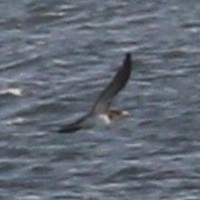Changes to the British List (8 June 2021)
The British Ornithologists’ Union Records Committee (BOURC) has made the following changes to the British List:
The following species has been added to the British List:
 Brown Booby Sula leucogaster
Brown Booby Sula leucogaster
One, second-calendar-year or older, Swalecliff, Kent, 19 August 2019.
Photo (right): © Andy Taylor
Brown Booby has been increasingly observed as a vagrant in the North Atlantic in recent years with birds moving north from their tropical breeding areas. Such movements may be due to increases in sea temperatures linked to climate change. So the observation of one in English coastal waters was predicted. Though the subspecific identification could not be determined it seems likely that this individual was of the nominate subspecies S. l. leucogaster which breeds in the Atlantic and Caribbean.
The probability of this individual being an escape from captivity was judged to be minimal. Whilst ship-assistance is always possible for extralimital Sula records, there is little reason to doubt that this species can also reach British shores unaided.
Thus the species was accepted to Category A.
It should be placed after Red-footed Booby Sula sula on the British List.
Brown Booby is polytypic, breeding in tropical areas of the Atlantic, Indian and Pacific oceans, and the Red Sea, where they are largely resident, with some birds moving limited distances.
The following species pair has also been accepted:
Southern Giant Petrel/Northern Giant Petrel Macronectes giganteus/ Macronectes halli
One, first-calendar-year or older, Whitburn, Co. Durham, 2 July 2019; same Cullernose Point, Northumberland, 2 July 2019.
This individual was watched as it tracked north along the coast of Co. Durham and Northumberland with the later observers being alerted of its trajectory through social media. Though this species pair is highly distinctive, separating the two from each other is challenging based on subtle differences in bill colouration, which could not be seen in such a distant “fly-by” bird. Hence the record was only accepted as the species pair.
The probability of this individual being an escape from captivity was judged to be minimal. Individuals of these taxa have been observed elsewhere in the North Atlantic, and this is an expected (if unlikely) vagrant.
As this record was not identified to species level, it is not included as part of the British List and is not included in the species totals, but is instead listed in Appendix 3 (IBIS 160: 239-240).
Southern Giant Petrel and North Giant Petrel are both monotypic, being widespread in the Southern Oceans and Antarctica where they breed. Both move north in the austral winter, but remain within the Southern Oceans.
These changes will be published as part of the BOURC’s 53rd report due to be published in IBIS in October 2021.
Upon publication of these changes, the British List stands at 623 species (Category A = 605; Category B = 8; Category C = 10).

